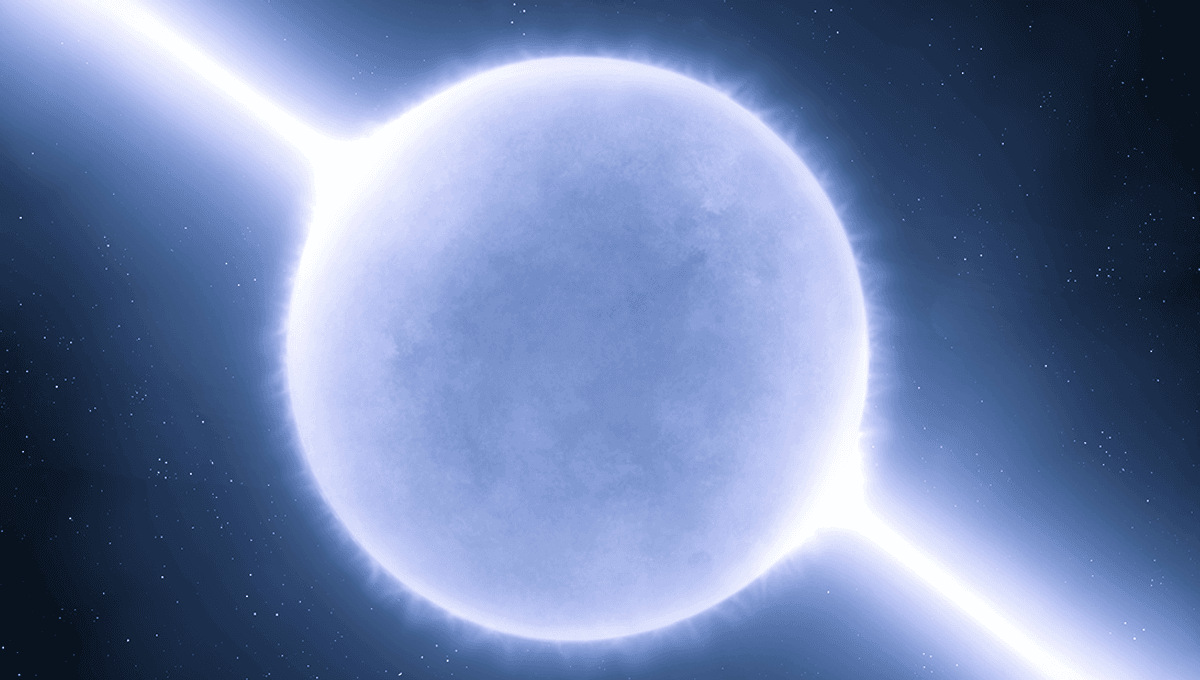-
Feed de Notícias
- EXPLORAR
-
Páginas
-
Blogs
-
Fóruns
Dead Pulsars Are Emitting Radio Waves. Massive "Mountains" Measuring 1 Centimeter Tall Could Be To Blame

Dead Pulsars Are Emitting Radio Waves. Massive "Mountains" Measuring 1 Centimeter Tall Could Be To Blame
New research from physicists at Peking University, China, suggests that some pulsars may have massive mountains on them, measuring up to 1 centimeter (0.4 inches) tall.
At the end of a giant star's life, the core collapses and the outer layers are blown away in a supernova explosion. After this, what is left behind is either a neutron star or a black hole, depending on the size of the original star. "While neutron stars’ dark cousins, black holes, might get all the attention, neutron stars are actually the densest material that we can directly observe," NASA explains. "To get an idea of how dense they are, one sugar cube of neutron star material would weigh about 1 trillion kilograms (or 1 billion tons) on Earth – about as much as a mountain. That is what happens when you cram a star with up to twice the mass of our Sun into a sphere the diameter of a city." In 1967, astronomers observed a number of unusual radio flashes coming from the sky. Originally designated LGM-1 (for "little green men" 1), some briefly put it down as a candidate for alien communication. However, we now know that these signals originate from pulsars, a new type of neutron star that produces light as it spins. "Pulsar radio emission is believed to be produced by a secondary electron-positron plasma generated in the polar regions of a neutron star," a paper on the topic explains. "This process includes primary particle acceleration by a longitudinal electric field, γ-quanta emission due to curvature radiation, production of secondary electron-positron pairs, and, finally, secondary particles acceleration in the opposite direction, which also leads to the creation of secondary particles." Here's where it gets puzzling. According to our best models, when a pulsar's spin slows down to a certain threshold – known dramatically as the "death line" – they should no longer emit radio waves, no longer having the powerful electric field required to produce them. And yet, there are pulsars out there – notably PSR J0250+5854 and PSR J2144-3933 – which continue to emit radio pulses, despite being below this "death line". It has been unclear exactly how these "dead" pulsars are "alive", but alive they certainly are. Teams have suggested in the recent past that an explanation might be teeny tiny (but still massive in the "mass" sense of the word) mountains at the surface of the neutron star. In this idea, if the surface is rugged with small "mountains" – sometimes called "zits" – it might enhance the parallel electric field near the surface of the stellar remnant, and in turn enhance positron acceleration. In the new work, which has not yet been peer reviewed, the team used complex mathematical frameworks to model neutron stars with small mountains at their surface, to see if they could be responsible for the radio signals we see from "dead" pulsars. "The results show that small mountains on a pulsar’s polar cap tend to significantly influence the properties of the inner vacuum gap, making it easier for sparks to form," they explain. "In this scenario, the magnetospheric activity observed from the pulsars PSR J0250+5854 and PSR J2144−3933, which lie below the pulsar death line, would be reproduced, and the irregular discharge behaviour in other polar cap regions could also be understood." According to the team, the "mountains" must be smaller than 1 centimeter tall. Any taller than this, and they would emit gravitational waves, draining the neutron star's rotational energy. While that may sound teeny tiny, it's not clear that structures that tall can last for very long. Previous research suggests they cannot be more than a few millimeters tall, or they could break the neutron star's crust. In the new work, the team suggests that if the mountains do exist, they could provide clues as to what goes on at the neutron star's surface, and inside neutron stars themselves. "Because of the extreme complexity of lattice quantum chromodynamics simulations non-perturbatively, it is currently impossible for us to theoretically determine the state of matter of pulsars," the team explains. "However, the presence of small mountains or other local uneven structures on the pulsar surface is a constraint on the state of matter because it requires the surface to have a strong shear modulus or the thermal electrons would destroy the mountain in the gap, so the surface matter must be solid with strong shear modulus." While we know that neutron stars are – surprise – mainly comprised of neutrons, their dense, extremely high-pressure cores are more of a mystery. One proposal, backed up a little by the latest research, is that neutron stars are made of "strangeon" matter, or "strange nucleon", where matter is held together by the strong nuclear force (which usually binds the nucleus of atoms together) instead of the electromagnetic force. "If a pulsar is a strangeon star proposed by Xu (2003) which takes into account the quark degrees of freedom, its surface would consist of strangeon matter, a condensate bound by the strong interaction with a binding energy of several MeV, much higher than the thermal energy of surface electrons," the team explains. "Consequently, the solid nature of the strangeon star’s surface enables the stable existence of local unevenness. Furthermore, from a symmetry-energy perspective, the strangeon phase is energetically favored over conventional neutron matter configurations." The team suggests that if there are small mountains on pulsars, China’s FAST (Five- hundred-meter Aperture Spherical Telescope) may be able to find further observational evidence of them, providing further clues as to what's going on inside these potentially very strange stars. The study is posted to pre-print server arXiv.


